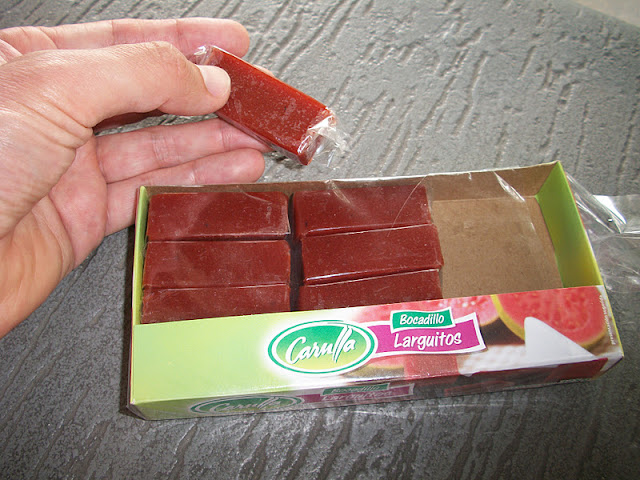One of Colombia's highlights is the food. I like the local cuisine because so much of it is unprocessed and complements endurance sports. Daily staples here include rice, beans, plantain, eggs, chicken and fresh fruit juice. It may sound a little bland to the sophisticated pallet, but the point is that its very healthy.
Colombia has approximately a dozen kinds of fruit you cannot get elsewhere. One of my favorite daily activities is walking down to the local Carulla (an upscale supermarket chain) to eat at the fruit bar. One kilogram of fruit costs $3. Examples of native fruits include guanabana, lulo, and uchuva.
A common breakfast food is Arepa de Chocolo con Quesito (corn arepa with cheese). Its a little heavy for me, but its tasty and packs 45 grams of carbs; perfect for a big day in the saddle.
Sometimes, you'll be lucky enough to find a Colombian selling juice and fruit at the top of a climb, particularly in the area just east of Medellin. The guy in the picture below has been at the top of La Union on every one of the three occasions I've climbed the mountain. He uses a blender to mix fresh squeezed orange juice with honey and vitamin supplements. A glass costs $1 and I would bet he probably has a very good business going.
Bocadillo is Colombia's version of energy gels. Back in the 1980s, the Colombian teams in Europe always raced with bocadillo in their back pockets. Its far less popular these days, but every now and then, I meet a Colombian powered by some serious bocadillo.
Bocadillo is made of guava paste and sugar. Its sweet, provides calories, cheap to buy, and - as you can see in the photo - is easy to carry.
Aguapanela was also popular with Colombian cyclists back in the days of Cafe de Colombia. Panela is a hardened piece of unrefined sugar, obtained by boiling and evaporating sugarcane juice. A block of panela (about the size of a suger cube) is then dissolved in hot water to produce a sweet drink. It is most commonly found in Colombia and Ecuador.
Similar to bocadillo, most Colombian cyclists have upgraded to Gatorade. Its mainly the poorer communities who still drink aguapanela. My Pinarello and Colnago-riding Colombian friends give me a strange look whenever I order aguapanela at a roadside cafe. But I don't mind - I'm the gringo.




Duncan! What a great experience!! Good luck in your trip around South America. Tito
ReplyDeleteThe fruit choices sound really nice. As does the corn arepa. Plenty of good food is a nice reward for all the cycling.
ReplyDeleteHey Dunkan good job with the Food
ReplyDeleteHere is some quick cultural info about la dulce Panela. Panela is often used as a sugar boost. Many people, including the FARC have written about using panel to endure long trips in the jungle. It is what was given to the three hostages when they were on long marches to help them make the trip as it is a low cost energy boost. They commented about it often in their book of their experience.
ReplyDeleteAlso, in many barrios, is is also used for slang in Colombia. For example if a male says someone says esta pa partir panela, it means something very important. Let's just say it is a hard candy.
Sorry...just thought I would add that. :)
I trained with a Columbian in Florida. He got me hooked on guava paste between slices of cheese. Awesome on a long ride.
ReplyDelete